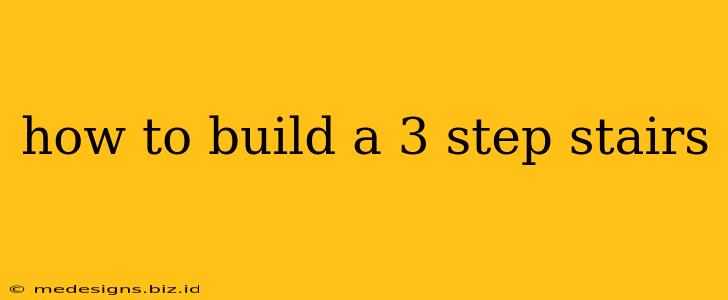Building a staircase might seem daunting, but with careful planning and the right tools, constructing a simple 3-step staircase is a manageable DIY project. This guide will walk you through the process, focusing on safety and precision. Remember to always prioritize safety and consult local building codes before beginning any construction project.
Step 1: Planning and Preparation
Before you even touch a tool, thorough planning is crucial. This phase ensures your staircase is safe, structurally sound, and aesthetically pleasing.
1.1. Measurements and Design:
- Determine the Rise and Run: The rise is the vertical height of each step, and the run is the horizontal depth. Standard building codes recommend a rise between 6-8 inches and a run between 10-12 inches. Consistency is key; every step should have identical rise and run measurements. Calculate the total rise by measuring the vertical distance between the top and bottom landing. Divide this by the number of steps (3 in this case) to get the ideal rise per step.
- Stringer Length Calculation: The stringers are the sloped supports that hold the steps. Use the Pythagorean theorem (a² + b² = c²) to calculate the length of each stringer. 'a' represents the total rise, 'b' represents the total run (number of steps x run per step), and 'c' is the stringer length.
- Material Selection: Choose durable and appropriately sized lumber for your stringers and treads (the horizontal stepping surfaces). Pressure-treated lumber is a good option for outdoor staircases, while hardwood offers a more aesthetically pleasing indoor solution.
1.2. Gather Your Tools and Materials:
- Measuring Tape: Crucial for accurate measurements.
- Level: Essential for ensuring level landings and steps.
- Saw (Circular Saw or Hand Saw): For cutting lumber to size.
- Drill: For pilot holes and securing components.
- Screws: Exterior-grade screws are recommended for outdoor staircases.
- Wood Glue: For added strength and stability.
- Safety Glasses and Gloves: Protect yourself from injury.
- Lumber: Calculate the amount needed based on your measurements (stringers, treads, risers (optional vertical supports between steps)).
- Optional: Post Supports: If needed for added stability.
Step 2: Cutting and Assembling the Stringers
This is where precision is key. Incorrect cuts will result in an unstable and unsafe staircase.
2.1. Marking and Cutting the Stringers:
- Layout: Carefully mark your stringer cuts based on your rise and run calculations. Using a speed square or a stair gauge will help ensure accurate angles.
- Cutting: Carefully cut the stringers using your saw. Multiple cuts are required to create the step notches. Take your time and make sure each cut is precise. Double-check your measurements before making each cut.
2.2. Attaching the Stringers:
- Securely Attach: Attach the stringers to the top and bottom landings using appropriate fasteners. Ensure they are level and plumb (vertical). Use additional support posts if needed, especially for longer staircases or those with significant height differences.
Step 3: Installing the Treads and Risers (Optional)
The final step is to complete the staircase's construction by installing the treads and risers (optional).
3.1. Attaching the Treads:
- Positioning: Carefully position and secure the treads onto the stringers using screws and wood glue. Ensure they are flush with the stringers and level. Pre-drilling pilot holes will prevent the wood from splitting.
3.2. Installing Risers (Optional):
- Optional but Recommended: While not strictly necessary for functionality, risers add a finished look and can increase the staircase's durability. Attach them to the stringers and treads using screws and wood glue.
3.3. Finishing Touches:
- Sanding and Finishing: Once the staircase is assembled, sand all surfaces smooth and apply a suitable finish to protect the wood. This can be paint, stain, or sealant, depending on your preference and the location of the staircase.
Building a 3-step staircase is a rewarding project that enhances both functionality and aesthetics. By meticulously following these steps and prioritizing safety, you can create a sturdy and attractive addition to your home. Remember to always consult with a professional if you have any doubts or concerns about your ability to complete this project safely.
